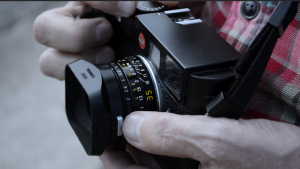Okay so I may or may not have been chronically ill Thursday morning during my Workshop, but I was told about this exercise by my friends so here I am. We were supposed to do this so that we might ‘consider and analyse the narrative structure of your PB3 portrait piece’. It’s just a few questions I’ve answered about my project. I skipped one or two just because they didn’t apply to my particular piece, but it was good activity to really get me thinking about it regardless.
- What is the ‘controlling idea’ of your portrait? My portrait focuses on the artistic career of my interviewee, David Wadelton. He is a painter but I focused specifically on his photography for this project. I wanted to focus on his photography because of his unique style. I suppose you could say the ‘controlling idea’ is to do with capturing a moment in history or noticing elements of our environment that you would usually take for granted – because this is what he does in his photography.
- How is your portrait film structured? Though still a working process, I’m primarily using face-to-face recorded interview for my project. This is the base narrative, so that I can experiment with cutaways, display his photography and also use found footage to help enhance the conversation while my interviewee narrates it.
- What do you want your audience to make of your interviewee? I think the thing I want them to get away from it is how much the world and our environment can change just through our life time. My interviewee talks about documenting Melbourne in the 70’s and how in many ways it has completely transformed since then.
- How is your portrait being narrated? It’s being narrated by the interviewee, so that the focus is entirely on him and his work. I chose this method because it is the most self contained, all footage is of him and recordings as well. But it also means focus won’t be detracted from the interviewee if you heard my voice or another person narrating.
- What role will the ‘found footage’ play in your portrait? The role of the found footage is actually pretty crucial, I’d say. Without giving too much away, I gained permission to use stock footage of Melbourne in the 60’s and 70’s to overlay while my interviewee discusses his photographic archive of the same era. It works really well to help enhance what he’s talking about, I think.
- Does your portrait have a dramatic turning point? No.
- How does your portrait gather and maintain momentum? It’s hard to say when it isn’t completed, but I think the use of cutaways and a few different angles helps to keep it interesting and maintain a flow that is engaging to the audience. I hope to use audio as a good momentum, having little to no silence but a steady flow so that it isn’t too much in one go.
